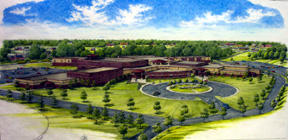
When conversation turns to developers’ stranglehold over local government, inevitably, people talk about some members of the Shelby County Board of Commissioners and Memphis City Council.
Almost never mentioned are the public officials who are so close to development interests that when they roll over in bed, they bump into them – the Shelby County Board of Education.
The overriding factor for school site decisions seems to be how they enrich developers, and in the past 15 years, the majority of new school sites have been associated with a single politically-connected developer. Last week, the board of education did it again. Not only did they pick a school site in southeast Shelby County that cost $2 million more than an alternate site, they consulted no one who should have a voice in their decision, especially Memphis City Schools and Memphis and Shelby County Division of Planning and Development.
For years, Shelby County Schools has plopped down schools across the landscape with no consideration of what will be needed by Memphis City Schools when the area is annexed. And yet, county schools expect the city schools district to buy the schools when Memphis extends its borders. Perhaps, with this new southeast Shelby County school, it’s time for Memphis City Schools officials to “just say no.”
If they did, Memphis City Schools would no longer accept whatever location it inherits from county schools. Instead, they would serve notice that they demand to be consulted on the front end. This stance would also force Shelby County Government officials to treat these decisions with the seriousness they deserve.
If Memphis City Schools said no, Shelby County Government would be forced to face the prospects of paying for a school with no real future. There’s the chance that after decades of turning a blind eye, county government would finally pay attention to the consequences of the school board’s decisions. Of course, developers might still have enough influence in the halls of county government to get whatever they want, but it would at least shine light on the most expensive decisions being made in this community.
Secondly, and even more stunning is the fact that Shelby County Schools thumbs its nose at the county regulation that requires that the siting of schools is reviewed by the Office of Planning and Development. This hasn’t been done in 16 years, during a period that will come to be known as Shelby County’s sprawl years.
No public entity has played a larger role in this sprawl than Shelby County Schools, and its unholy alliance with the development industry has made it incapable of any perspectives that might lead to different outcomes. If county government forced its school district to consult with OPD, schools officials would be confronted with statistics, demographic trends and building permit numbers that have shown over the years that it has routinely put its schools in the wrong places. In fact, they were put in the very places that fueled sprawl the most.
Most of all, the county school district’s unilateral process means that decisions are never placed in a broader perspective. They are not dovetailed with public service demands, which means that county government cannot prepare financially and programmatically for the future, but, instead, has to react to forces set in motion by its own board of education.
The inevitability built into the system is startling, especially considering that decisions made by the Shelby County Board of Education are responsible for at least half of the county’s suffocating debt. The spectacle of the county school system making its decisions in isolation is especially incredulous now, as the Wharton Administration tries to pay down the county’s $2.2 billion debt.
Despite the much ballyhooed announcements about better coordination, cooperation and communications about schools – whether in the needs assessment process set up by Mayor Wharton or the school consolidation (now the school funding) committee set up by Mayor Herenton – the consultation that is at the root of real collaboration is missing as long as collaboration by Shelby County Schools is only with developers. In rejecting the site and paying $2 million more for a site, the school board said the cheaper site was too close to the edge of its service district (or in layman’s terms, too close to the Mississippi state line). Of course, a couple of years ago, it didn’t concern school officials at all when it snuggled the Arlington School site awfully close to the Fayette County border, but then again, that was a site that developers insisted on having.
A first and simple step toward putting order in this process would be for the county administration and board of commissioners to instruct the school board to confer with Memphis City Schools and OPD to see what it considers the optimum location for new schools and to discuss them openly. Perhaps, then, decisions on county schools’ sites could pass the smell test, which now have the distinct aroma of cigar smoke in a back room.


